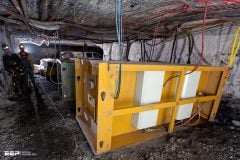Sample calculation for small LT system
Fault calculations are carried out to find the magnitude of fault current at various voltage levels of electrical system. One of the key components in the calculation process is to determine the total impedance of the circuit from the utility / source, through the transmission system, transformers, and conductors, down to the point in question such as a panel or switchboard location.

Continued from previous technical article: An Overview Of Short Circuit Current (part 2)
The impedances of the various circuit elements have both resistance and reactance and are often referred to as the “complex impedance” or “polar notation”. Short circuit calculations are actually just an elaborate version of Ohm’s Law.
Fault current values and time helps in deciding equipment short time withstand capacity and deriving settings of protection relays. Interrupting capacity of protection equipment should be high enough to open safely the maximum short circuit current which the power system can cause to flow through that equipment.
One sample calculation for calculating the short circuit current at downstream of transformer is shown below.
Calculation basis
1/ The busbar and switchgear of Marshalling kiosk is sized for short time rating as per contribution from MV source through LT transformer.
2/ For circuits connected by transformer PU system is particularly suitable. By selecting suitable base kV for circuits the per unit reactance and resistance remains same, referred to either side (HV or LV) of transformer.
3/ For circuits connected by transformer same base kVA is selected for both the circuits (HV and LV) because power remains constant throughout so same base kVA should be considered throughout.
4/ As a rule only two bases should be selected first and from these two the remaining bases should be calculated. This is so because kV, kVA, I and Z are interrelated. They must obey ohms law. If we select base kVA and base kV than other base like base I and base Z are calculated from base kV and base kVA.
Vice-versa will be inconvenient that is selecting base I and Z and calculating other bases like kV and kVA will make calculation difficult.
| Input data to be collected: | ||
| 1. Transformer Rating | = | 0.63 MVA |
| 2. Transformer Voltage ratio | = | 11/0.433 kV |
| 3. Frequency | = | 50Hz |
| 4. Transformer Impedance | = | 5% = 0.05 PU |
| 5. MV System fault level (Maximum) | = | 40 kA |
| 6. MV System fault MVA | = | √3 x 40 x 11 = 762 MVA |
Calculation
| Actual Fault Current available at AC distribution board | ||
| Base MVA | = | 0.63 |
| Base kV | = | 11 |
| Base Current in kA | = | Base MVA/(√3 x Base kV) = 0.63/(√3 x 11) = 0.033 |
| Base Impedance = (Base kV)2 / Base MVA | = | 192.1 |
| Source Impedance = MV System fault MVA / Base MVA | = | 0.0008 |
| LT Transformer impedance at 0.63MVA & 11kV Base | = | 0.05 |
| Total MV system impedance (MV System + LT Transformer) | = | 0.0508 |
| Fault MVA contributed by Source through LT Transformer | = | Base MVA / Total Impedance |
| = | 0.63 / 0.0508 = 12.40 | |
| Fault current contribution in kiloAmpers from MV system at LV side through (Switchyard) LT Transformer: | ||
| = | Fault MVA x 1000 x 1000 / (√3 x 0.433 x 1000 x 1000) | |
| = | 12.40 x 1000 x 1000 / (√3 x 0.433 x 1000 x 1000) | |
| = | 17.245 kA | |
Actual Fault Current available at marshalling kioskbusbar
Busbars and switchgear components of marshalling kiosk shall be braced for the peak value of the faultcurrent contribution from the MV system through 630kVA rated source transformer.
Hereafter Marshalling kiosk to be referred as BMK and AC distribution board to be referred as ACDB.

Base kVA = same as above, since this parameter remains constant throughout the circuit
Base kV = 0.415V Base kV at LV circuit
Distance in meters of transformer from ACDB = 20
Distance in meters of BMK from ACDB = 50
Size of connecting cable in Sq mm from transformer to ACDB = 3.5C x 300 Sq mm Al, XLPE
Resistance in Ohms/kM of connecting cable from transformer to BMK = 0.128
Total resistance over route length = 20×0.128 /1000 = 0.003
PU resistance = Actual Resistance x Base kVA/ (BasekV2 x 1000)
= 0.003 x 0.63 x 1000 / (0.415 x 0.415 x 1000) = 0.009
Reactance in Ohms/kM of connecting cable from transformer to BMK = 0.0705
Total reactance over route length = 0.0705×20 /1000 = 0.001
PU reactance = Actual Reactance x Base kVA/(Base kV2x 1000)
= 0.001 x 0.63 x 1000 / (0.415 x 0.415 x 1000) = 0.0052
PU impedance of cable from LT transformer to ACDB
= √((PU resistance)2+(PU reactance)2)= √(0.0092+ 0.07052) = 0.011
Size of conecting cable in Sq mm from ACDB to BMK = 3.5C x 35 Al, XLPE
Resistance in Ohms/kM of connecting cable from ACDB to BMK = 0.671
Total resistance over route length = 0.671 x 50 /1000 = 0.034
PU resistance = Actual Resistance x Base kVA/(Base kV2 x 1000)
= 0.034 x 0.63 x 1000 / (0.415 x 0.415 x 1000) = 0.12
Reactance in Ohms/kM of connecting cable from ACDB to BMK = 0.0783
Total reactance over route length = 0.0783 x 50 /1000 = 0.004
PU reactance = Actual Reactance x Base kVA/(Base kV2x 1000)
= 0.004 x 0.63 x 1000 / (0.415 x 0.415 x 1000) = 0.14
PU impedance of cable from ACDB to BMK = √((PU resistance)2+(PU reactance)2) = √((0.12)2+(0.14)2) = 0.124
Total PU Impeadnce of connecting cable from LT transformer to BMK = 0.011 + 0.124 = 0.134
Total PU Impedance from LT Transformer to BMK = PU Impedance of Transformer + Total PU
Impedance of connecting cable from LT transformer to BMK = 0.05 + 0.134 = 0.1842
Fault MVA at BMK busbar = Base MVA/Total Impedance = 0.63 / 0.1842 = 3.42
Fault current in kiloAmps at BMK busbar = Fault MVA x 1000x 1000 / (√3 x 0.415 x 1000 x 1000)
= 3.42 x 1000 x 1000 / (√3 x 0.415 x 1000 x 1000) = 4.757 kA
Hence selection of 10kA busbar and switchgear components like MCB is safe and appropriate as per the actual fault level existing at BMK main busbar.
| Si. No | Equipment | CURRENT RATING | |||
CALCULATED SHORT | OPTIMUM SELECTION | ||||
| RMS Symmetrical | Assymmetrical peak value = nxRMS Symmetrical | RMS Symmetrical | Assymmetrical peak value = nxRMS Symmetrical | ||
| 1 | Main LT board | 17.24 | 34.5 (n=2) | 35 | 73.5 (n=2.1) |
| 2 | Marshalling kiosk | 4.75 | 7.1 (n=1.5) | 10 | 17 (n= 1.7) |
References:
- Indian Standard 8623, part-1-SPECIFICATION FOR LOW-VOLTAGE SWITCHGEAR AND CONTROLGEAR ASSEMBLIES
- Indian Standard 10118, part-2-CODE OF PRACTICE FOR THE SELECTION, INSTALLATION AND MAINTENANCE OF SWITCHGEAR AND CONTROLGEAR
- The Importance of the X/R Ratio in Low-Voltage Short Circuit Studies- Research paper DATE: November 17, 1999 REVISION: 0 by AUTHOR: John Merrell
- Short-circuit-current Calculating Procedures by Donald Beeman, Alan Graeme Darling, and R. H. Kaufmann
- Industrial Power Engineering and Applications Handbook by K.C. Agrawal











Sir:
I observed that You have mentioned the transformer ratio as 11/0.433 kV but worked using 0.415 kv as secondary. Otherwise Fault current would not have come as 17.245 kA.
Any reason?
433V is no load voltage of transformer. Ones the load is connected the voltage across transformer secondary is 415V
Dear Asef,
As along time of reading and searching for exisiting of 3 phase fault to ground in the electrical system or not. actually, i refered to many standards searching for type of short circuits which is single phase to earth, two phase, two phase to earh and three phase faults. kindly can you inform me if there is a three phase to earth fault in the electrical system or not and if yes please identify a reference standard.
thank you
Yes its there. 3 Phase to ground fault (LLLG) fault is also one of the type of faults. You can refer the references mentioned in this article
Muchas gracias por los documentos, excelente trabajo.
Asif Eqbal sahab Asalamalikum,
I’m new to this site and after reading the author description i think u might help me. I graduated in Electrical & Electronics Engg. how and what skill do i need to develop to succeed, any courses or whatever. Can u please guide me.
Source Impedance = MV System fault MVA / Base MVA = 0.0008
MV System fault MV = 762 – Base MVA = 0.63 ie 762/0.63 not equal to 0.0008
I hope it may be reverse
Base MVA / MV System fault MVA
yes it is base MVA/System fault level typographical error is regretted
Yes it is typographical error
this was really good articles 3 parts gives a lot of information